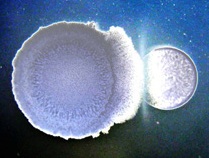Imaging reveals key metabolic factors of cannibalistic bacteria
By By Scott LaFee | 04 Sep 2010
Researchers at the University of California, San Diego have revealed new details about how cannibalistic bacteria identify peers suitable for consumption. The work, which employed imaging mass spectrometry, is a first step toward a broader effort to map all signaling molecules between organisms.
 ''These are the molecules that control biology,'' said Pieter C. Dorrestein, PhD, associate professor at UC San Diego's Skaggs School of Pharmacy and Pharmaceutical Sciences and corresponding author of a paper published this week in the online edition of the Proceedings of the National Academy of Sciences.
''These are the molecules that control biology,'' said Pieter C. Dorrestein, PhD, associate professor at UC San Diego's Skaggs School of Pharmacy and Pharmaceutical Sciences and corresponding author of a paper published this week in the online edition of the Proceedings of the National Academy of Sciences.
Bacterial cannibalism occurs when a subpopulation of a microbial colony eats another subpopulation, harvesting the latter's nutrients to sustain growth in times when external food sources are limited. The phenomenon is well-known, but not well-characterized. For example, researchers have not known exactly how microbes identify, select and kill their genetically identical siblings.
Dorrestein, with colleagues at UC San Diego and in Iowa and Texas, studied Bacillus subtilis, a common species with a complex life cycle that thrives in diverse living conditions, from soil to contaminated wounds to the intestinal tract. Using imaging mass spectrometry, the researchers generated spatial distributions or chemical maps of molecules within the microbe, focusing in particular on two metabolites called sporulation delaying protein (SDP) and sporulation killing factor (SKF), which the scientists correctly hypothesized were directly involved in the cannibalistic process.
''These are the first fully characterised molecules that enable B. subtilis to 'digest' or differentiate genetically identical cells,'' said Dorrestein. ''Our work also shows that the molecules the bacteria uses to differentiate themselves are akin to those of a multicellular organism, even though the microbes are genetically identical. Most people do not think of a microbial colony as a differentially organized multicellular organism.''
Since SDP and SKF were involved in killing bacteria, the scientists also explored whether the molecules might be effective weapons against human pathogens. Their findings were mixed. SKF had no effect on targeted pathogens like Pseudomonas aeruginosa or Klebsiella pneumonia, but SDP displayed potent inhibitory activity against two variants of Staphylococcus aureas and other pathogens.













.jpg)






.jpg)









